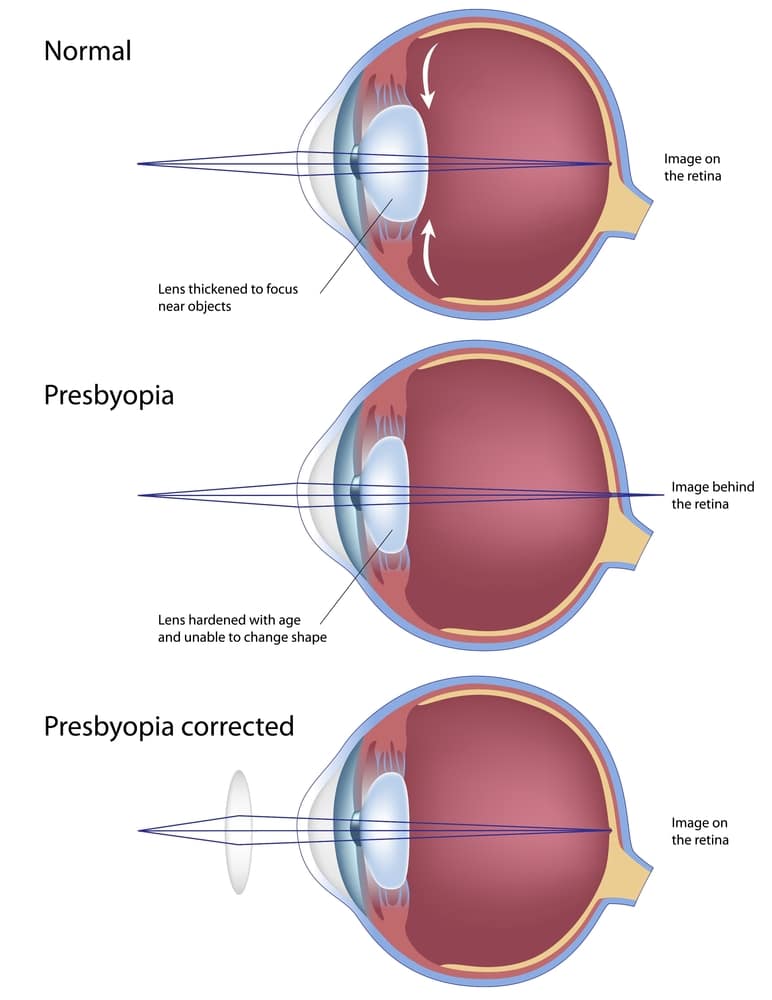Aging is part of life, and one thing that changes with age is your vision. Even if you’ve had 20/20 vision your whole life, most people develop some degree of presbyopia in their forties or fifties.
Presbyopia is an age-related eye condition that makes it harder to see up close. Many people with presbyopia turn to reading glasses to see when reading or doing other fine focus tasks.
But if you have an existing refractive error, like nearsightedness or astigmatism, you often have to switch between your regular glasses to see at a distance and reading glasses to see up close. Some people with refractive errors and presbyopia use bifocals.
Bifocals function like glasses on the top and reading glasses on the bottom. But another option that’s even more convenient than bifocals is progressive lenses.
Keep reading to learn more about the advantages of choosing progressives and how presbyopia can affect your vision!
What is Presbyopia?

Presbyopia is an age-related eye condition that occurs when your eye’s natural lens becomes less flexible. The natural lens losing flexibility is usually a simple result of aging.
When the lens becomes less flexible, it is more challenging to focus, making it harder to see up close. You may struggle to see the ball while golfing, be unable to read a menu at a restaurant or find driving more challenging when you can no longer see easily up close.
Reading glasses can help people with presbyopia see up close by magnifying text and other objects up close. But because reading glasses magnify images, they make it harder to see at distances that aren’t up close.
That means you can only wear reading glasses to see if you’re using them to see objects right before you. If you’re nearsighted or have astigmatism, switching between your prescription glasses and reading glasses can be challenging, so many people opt for bifocals.
But bifocals still have some drawbacks. Progressive lenses are more advanced and help you see at all distances seamlessly.
What are Progressive Lenses?
Progressive lenses have three sections instead of the two sections used for bifocal lenses. One section helps you see at a distance, one enables you to see up close, and one allows you to see at a middle distance.
But unlike bifocals, the split between these sections isn’t sudden; it’s progressive. The sections are blended, transitioning from one refractive power to another.
Having three different refractive powers and a smooth transition between the sections gives progressive lenses many advantages over reading glasses and bifocal lenses.
Clearer Vision at More Distances

Progressive lenses help you see both up close, at a distance, and a middle distance. Bifocals only help you see at a standard reading distance of 16 inches and greater distances. However, progressive lenses also help you see clearly at arm’s length.
With progressive lenses, you can see not only up close and far away but also quite clearly between the two distances. The smooth transition between distances helps you see several distances between up close and far away.
You’ll be able to see at more than an arm’s length away, although your vision is clearest at each of these three distances.
Easy Transition Between Multiple Distances
With bifocals, people often experience an “image jump” when looking from one side of the lens to another. Progressive lenses smooth the transition between different distances, so you don’t experience this jump when looking from one side of the lens to another.
You’ll be able to go from looking at something at one distance to another without refocusing your eyes or noticing any discernible change in image quality. Instead, you can look forward to crisp, clear vision, no matter what distance you’re at.
Better for Computer Work
Because progressive lenses allow you to see quite well at a middle distance, they’re great for anyone who works at a computer. Screens are best viewed at least an arm’s length away, as sitting too close can cause eye strain.
With progressive lenses, you can sit at a safe distance from the screen while still seeing everything on the screen clearly. There are even progressive lenses specifically designed for computer work.
These lenses have a more extensive section dedicated to intermediate-distance vision. While these glasses are a good choice for people who work on the computer, regular progressive lenses are still helpful for computer work and just viewing your phone, tablet, or TV screen from a safe distance.
They Look Like Normal Glasses!
Bifocals have a noticeable line down the middle since the transition between the top and bottom part of the lens is quite sudden. Some people are self-conscious about wearing bifocals because they’re easily identifiable and are associated with aging.
While there’s no shame in getting older and needing different kinds of glasses to see, progressive lenses do away with any concerns you may have with the stigma of wearing bifocals. Progressive lenses look like regular glasses, so no one can tell by looking that you need reading glasses.
Are Progressive Lenses Right for You?

You may be a good fit for progressive lenses if you have presbyopia and an existing refractive error. If you want seamless vision at multiple distances, they are worth considering. However, it can take a little time to adjust to wearing them.
But once you get used to them, you’ll have seamless vision at all distances. You also won’t have to worry about using reading glasses! Learn more about progressive lenses by requesting an appointment today at Traverse City Eye in Traverse City, MI! Isn’t it time for better vision that will also change your life?
